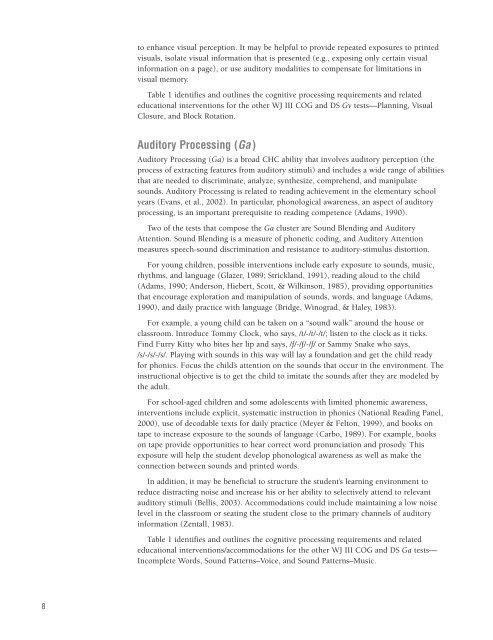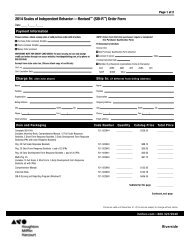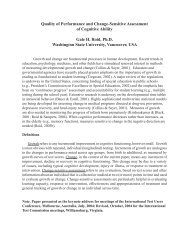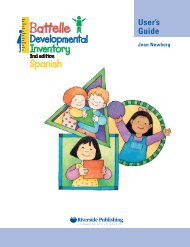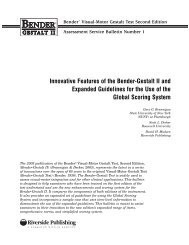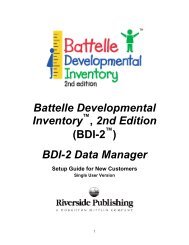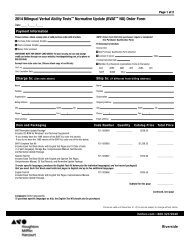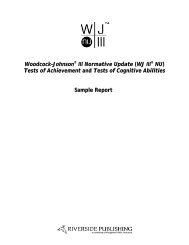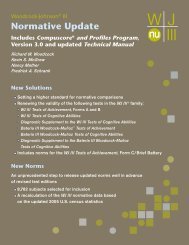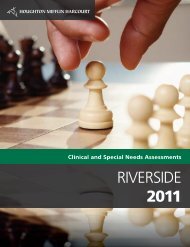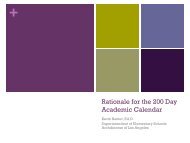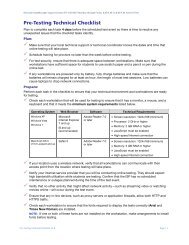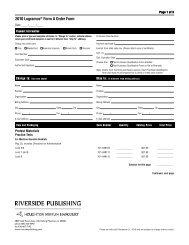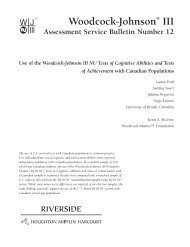Woodcock- Johnson III Tests of Cognitive Abilities - Riverside ...
Woodcock- Johnson III Tests of Cognitive Abilities - Riverside ...
Woodcock- Johnson III Tests of Cognitive Abilities - Riverside ...
You also want an ePaper? Increase the reach of your titles
YUMPU automatically turns print PDFs into web optimized ePapers that Google loves.
to enhance visual perception. It may be helpful to provide repeated exposures to printedvisuals, isolate visual information that is presented (e.g., exposing only certain visualinformation on a page), or use auditory modalities to compensate for limitations invisual memory.Table 1 identifies and outlines the cognitive processing requirements and relatededucational interventions for the other WJ <strong>III</strong> COG and DS Gv tests—Planning, VisualClosure, and Block Rotation.Auditory Processing (Ga )Auditory Processing (Ga) is a broad CHC ability that involves auditory perception (theprocess <strong>of</strong> extracting features from auditory stimuli) and includes a wide range <strong>of</strong> abilitiesthat are needed to discriminate, analyze, synthesize, comprehend, and manipulatesounds. Auditory Processing is related to reading achievement in the elementary schoolyears (Evans, et al., 2002). In particular, phonological awareness, an aspect <strong>of</strong> auditoryprocessing, is an important prerequisite to reading competence (Adams, 1990).Two <strong>of</strong> the tests that compose the Ga cluster are Sound Blending and AuditoryAttention. Sound Blending is a measure <strong>of</strong> phonetic coding, and Auditory Attentionmeasures speech-sound discrimination and resistance to auditory-stimulus distortion.For young children, possible interventions include early exposure to sounds, music,rhythms, and language (Glazer, 1989; Strickland, 1991), reading aloud to the child(Adams, 1990; Anderson, Hiebert, Scott, & Wilkinson, 1985), providing opportunitiesthat encourage exploration and manipulation <strong>of</strong> sounds, words, and language (Adams,1990), and daily practice with language (Bridge, Winograd, & Haley, 1983).For example, a young child can be taken on a “sound walk” around the house orclassroom. Introduce Tommy Clock, who says, /t/-/t/-/t/; listen to the clock as it ticks.Find Furry Kitty who bites her lip and says, /f/-/f/-/f/ or Sammy Snake who says,/s/-/s/-/s/. Playing with sounds in this way will lay a foundation and get the child readyfor phonics. Focus the child’s attention on the sounds that occur in the environment. Theinstructional objective is to get the child to imitate the sounds after they are modeled bythe adult.For school-aged children and some adolescents with limited phonemic awareness,interventions include explicit, systematic instruction in phonics (National Reading Panel,2000), use <strong>of</strong> decodable texts for daily practice (Meyer & Felton, 1999), and books ontape to increase exposure to the sounds <strong>of</strong> language (Carbo, 1989). For example, bookson tape provide opportunities to hear correct word pronunciation and prosody. Thisexposure will help the student develop phonological awareness as well as make theconnection between sounds and printed words.In addition, it may be beneficial to structure the student’s learning environment toreduce distracting noise and increase his or her ability to selectively attend to relevantauditory stimuli (Bellis, 2003). Accommodations could include maintaining a low noiselevel in the classroom or seating the student close to the primary channels <strong>of</strong> auditoryinformation (Zentall, 1983).Table 1 identifies and outlines the cognitive processing requirements and relatededucational interventions/accommodations for the other WJ <strong>III</strong> COG and DS Ga tests—Incomplete Words, Sound Patterns–Voice, and Sound Patterns–Music.


